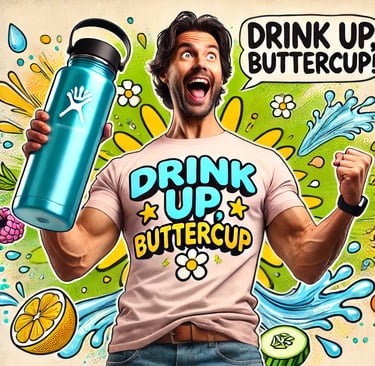

Drink Up, Buttercup: Why Water is Your Secret Weapon and How to Use It
Hydration used to feel optional—like flossing or returning library books on time. Now, it’s practically a lifestyle. Kids today won’t leave the house without their Stanley or Hydro Flask, and I’m over here thinking, “You couldn’t get me to drink water until I was 30.” If staying hydrated feels like an afterthought, don’t worry—I’ve got tips to make it easy!
Why Staying Hydrated Matters (Especially for Chronic Conditions)
Water is life—literally. Your body is about 60% water, and staying hydrated keeps everything running smoothly, from your brain to your muscles.
Here’s why it’s critical:
Brain Power: Even mild dehydration can affect focus, memory, and mood. If you’re feeling foggy or irritable, try a glass of water before blaming your morning.
Symptom Management: For those with chronic conditions, dehydration can exacerbate symptoms like pain, fatigue, and dizziness. It’s like your body’s check engine light flashing, but louder.
Energy Levels: Water is essential for transporting oxygen and nutrients to your cells. No water = tired cells = tired you.
Digestive Health: Staying hydrated helps prevent constipation and aids in digestion. Bonus: it can also ease bloating.
Pain Relief: Dehydration can make joint pain or muscle cramps worse. Your body needs fluid to lubricate joints and relax tense muscles.
How Much Water Do You Really Need?
The magic number is half your body weight in ounces of water per day. For a 150-pound person, that’s 75 oz. If you’re sweating it out in the gym or dealing with heat, add another 16-24 oz for every hour of activity.
Pro Tip: Don’t chug it all at once—unless you’re aiming to feel like a water balloon. Use a bottle marked with ounces or one of those motivational bottles that says, “Drink this by noon.” If you’re already tracking calories with an app, check if it lets you log water intake too—it’s like multitasking for your health.
Hydration Hacks That Actually Work
“Just drink more water” isn’t always helpful advice. Here are some creative ways to make it easier:
Infuse It: Add a little pizzazz to your water with lemon, mint, or berries. Suddenly, it’s spa water.
Hydration Before Hunger: Drink a glass before meals. It not only helps with hydration but also prevents overeating.
Hydrate Early: Start your day with a big glass of water. Put a sticky note on your coffee maker: “Water first, caffeine second!”
Gadget Goals: Reward yourself with a fancy bottle you’re excited to carry—Hydro Flask, Stanley, or whatever makes you feel like a hydration pro.
Track It: Use apps or a bottle with time markers to keep you on schedule. Small sips throughout the day are better than guzzling gallons at night.
Hydration Is More Than Just Water
True hydration is about balance. Your body needs electrolytes—sodium, potassium, magnesium, and calcium—to keep muscles working, nerves firing, and cells happy. Without them, you might face muscle cramps, fatigue, or even worse symptoms if you have a chronic condition.
Here’s the lineup:
Sodium: Keeps fluids balanced and muscles functioning. Broths and lightly salted snacks are great sources.
Potassium: Fights cramps and regulates muscle contractions. Bananas, sweet potatoes, and oranges are potassium-packed.
Magnesium: Relaxes muscles and supports energy production. Get it from nuts, seeds, and spinach.
Chloride: It works alongside sodium to help regulate fluid balance, maintaining fluid levels inside and outside cells, and acid-base balance.
Calcium: Vital for muscle and nerve health. Dairy, fortified plant milk, and leafy greens have you covered.
Signs You’re Dehydrated
Dehydration isn’t just about thirst. Watch out for:
Dark Urine: Pale yellow is ideal; dark like apple juice means you need more water.
Fatigue: When your body doesn’t have enough water, it struggles to deliver nutrients and oxygen.
Dry Mouth or Skin: Feeling like the Sahara Desert? Time to sip.
Headaches and Dizziness: These can often be fixed by rehydrating, not just another cup of coffee.
Beyond the Bottle: Creative Hydration
Water’s not your only option. Keep things interesting with these choices:
Coconut Water: A natural electrolyte source, great after exercise.
Hydrating Foods: Snack on watermelon, cucumbers, or oranges—they’re packed with water and nutrients.
Homemade Electrolyte Drinks: Mix water, a pinch of sea salt, lemon juice, and a little honey for an easy DIY fix.
Store bought Electrolyte Drinks: There are tons of options out there! I personally like Liquid I.V. hydration, but look for ones that incorporate electrolytes like potassium, magnesium, sodium, and chloride.
Herbal Teas: Peppermint, chamomile, or rooibos are hydrating alternatives to plain water.
Final Thoughts
Hydration isn’t just about feeling less thirsty—it’s about giving your body what it needs to function at its best. Whether you’re pacing yourself with a time-marked water bottle, logging sips in an app, or grabbing electrolytes from food, staying hydrated can improve your energy, focus, and overall wellness.
So, grab a glass—whether it’s your Stanley, a fancy infuser bottle, or (if you’re like me) a trusty red Solo cup filled with tap water. Take a sip, feel like a champ, and remember: your body will thank you for it. Cheers to crushing those hydration goals!
Drink Up, Buttercup: Why Water is Your Secret Weapon and How to Use It
ESSENTIAL WELLNESS
12/3/2024
Vaccine Injury Healing
© 2024. All Rights Reserved
Brought to you by Dr. Nikki Holland
